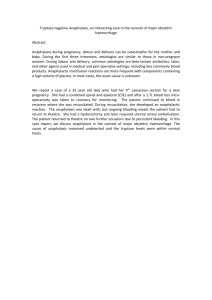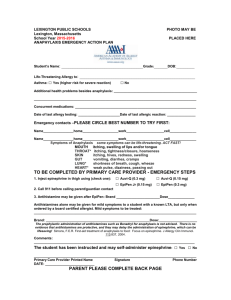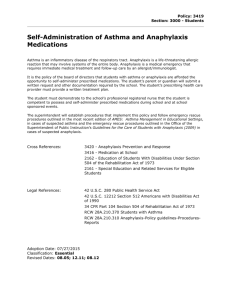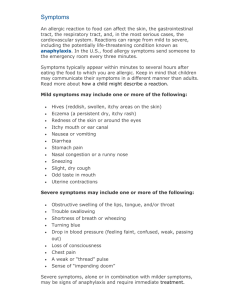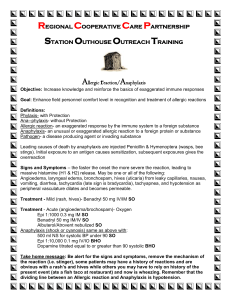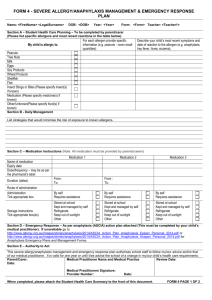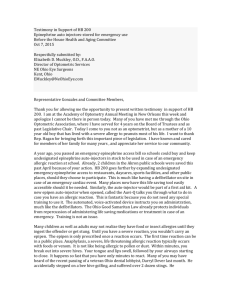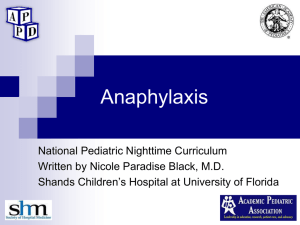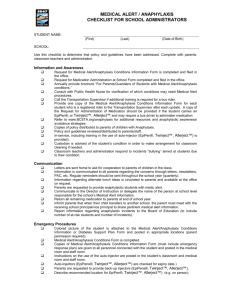ANAPHYLAXIS MANAGEMENT POLICY Anaphylaxis is a severe
advertisement
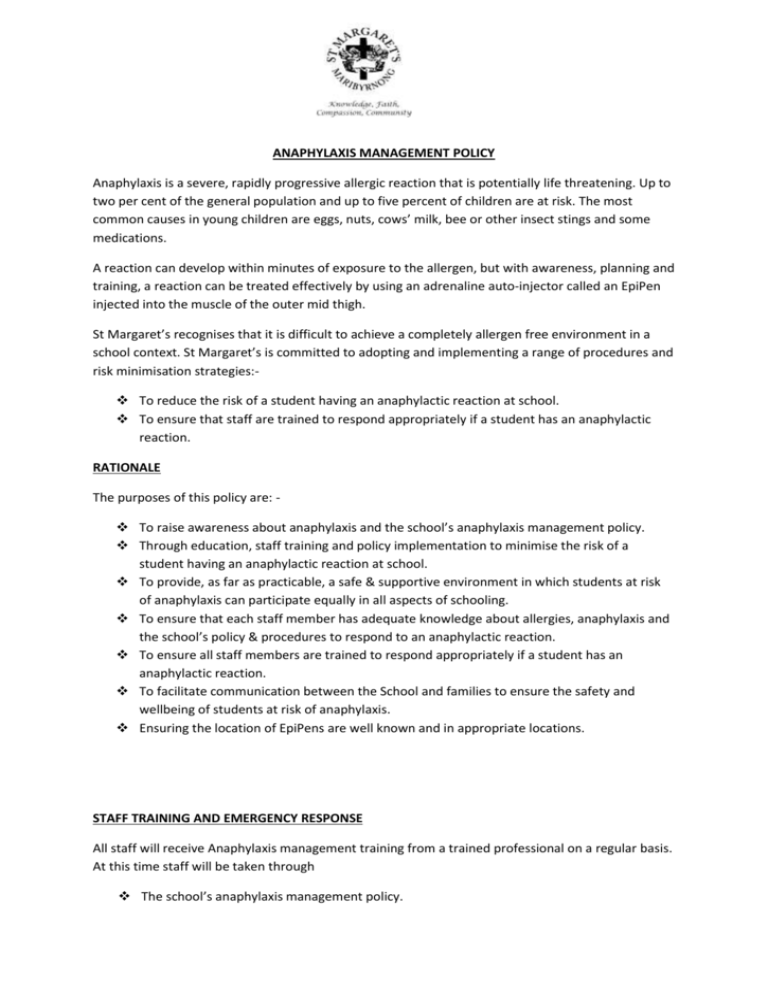
ANAPHYLAXIS MANAGEMENT POLICY Anaphylaxis is a severe, rapidly progressive allergic reaction that is potentially life threatening. Up to two per cent of the general population and up to five percent of children are at risk. The most common causes in young children are eggs, nuts, cows’ milk, bee or other insect stings and some medications. A reaction can develop within minutes of exposure to the allergen, but with awareness, planning and training, a reaction can be treated effectively by using an adrenaline auto-injector called an EpiPen injected into the muscle of the outer mid thigh. St Margaret’s recognises that it is difficult to achieve a completely allergen free environment in a school context. St Margaret’s is committed to adopting and implementing a range of procedures and risk minimisation strategies: To reduce the risk of a student having an anaphylactic reaction at school. To ensure that staff are trained to respond appropriately if a student has an anaphylactic reaction. RATIONALE The purposes of this policy are: To raise awareness about anaphylaxis and the school’s anaphylaxis management policy. Through education, staff training and policy implementation to minimise the risk of a student having an anaphylactic reaction at school. To provide, as far as practicable, a safe & supportive environment in which students at risk of anaphylaxis can participate equally in all aspects of schooling. To ensure that each staff member has adequate knowledge about allergies, anaphylaxis and the school’s policy & procedures to respond to an anaphylactic reaction. To ensure all staff members are trained to respond appropriately if a student has an anaphylactic reaction. To facilitate communication between the School and families to ensure the safety and wellbeing of students at risk of anaphylaxis. Ensuring the location of EpiPens are well known and in appropriate locations. STAFF TRAINING AND EMERGENCY RESPONSE All staff will receive Anaphylaxis management training from a trained professional on a regular basis. At this time staff will be taken through The school’s anaphylaxis management policy. The causes, symptoms and treatment of anaphylaxis. The identities of students diagnosed at risk of anaphylaxis and the location of their medication. How to use an auto adrenaline injecting device. The School’s first aid and emergency response procedures. While the student is under the care or supervision of the school, including excursions, yard duty, camps and special event days, it must be ensured that there is a sufficient number of staff present who has current training in anaphylaxis management. The school has developed a Velcro bag system for medication to be taken on excursion. All anaphylaxis medication taken on excursion must be logged out and in. POLICY \ PROCEDURES Staff briefings and accredited anaphylaxis management training is completed every two years. Procedures are in place for informing casual relief teachers or volunteers of: The students at risk of anaphylaxis; The symptoms of an anaphylactic reaction; The students’ allergies and the individual anaphylaxis management plans; and the location of the EpiPen kits. This important information is on display in the staffroom, First Aid room and in the teachers’ folder in the classroom. Ensure that an anaphylaxis management action plan is provided to St Margaret’s by parent / caregiver and has been signed by the student’s registered medical practioner. Record when the student’s anaphylaxis action plan is provided. Record expiry date of the EpiPen. Check that a complete EpiPen kit is supplied for the student and is stored in the sick bay that is known to all staff and easily accessible to adults. Display an ambulance contact card by telephones. All parents/guardians as part of the enrolment procedure, prior to their child’s attendance at the School, are asked whether the child has allergies and this information is documented on the child’s enrolment record. If the child has severe allergies, the parents/guardians are asked to provide an anaphylaxis action plan signed by a registered medical practitioner. Ensure that a student’s individual anaphylaxis action plan signed by a registered medical practitioner is inserted into the enrolment records for that student. This will outline the allergies and describe the prescribed medication for that student and the circumstances in which it should be used. Role of staff responsible for the student at risk of anaphylaxis A copy of the student’s anaphylaxis action plan is displayed in the staffroom and around the school and is visible to all staff. EpiPen expiry dates are checked at the commencement of each year. A copy of the student’s anaphylaxis management plan is also stored with the EpiPen kit. The student’s anaphylaxis action plan in the event of an allergic reaction is followed. Where a student who has not been diagnosed as allergic, but who appears to be having an anaphylactic reaction the process is to: . Call an ambulance immediately by dialling 000. . Commence first aid measures. . Contact the parent/guardian or person to be notified in the event of illness if parent/guardian cannot be contacted. Food sharing is not allowed between students without parental permission. The practice where the student at risk of anaphylaxis eats only that food that is supplied or permitted by the parent\guardian, and does not share food with, or accept other food from any other person. Ensure that the students’ birthday \treats are water icy poles only. Ensure that the EpiPen kit for each student at risk of anaphylaxis is carried by a trained adult on excursions that this student attends. Role of Parent/Caregiver Inform Principal and Head of School in writing that their child is at risk of Anaphylaxis [on enrolment or on diagnosis of their child’s condition.] Read and be familiar with the School’s Anaphylaxis Management Policy. Notify the School in writing of any advice from medical practitioner. Provide the School with an anaphylaxis action plan signed by a registered medical practitioner giving written consent to use the EpiPen in line with this action plan. Provide a complete EpiPen kit to School. Ensure EpiPen is clearly labelled with student’s name and not out of date. Replace EpiPen when it expires or upon being informed by staff that it has been used. Notify staff of any changes to their child’s allergy status and provide a new anaphylaxis action plan in accordance with these changes. Assist staff by offering information and answering any questions regarding their child’s allergies. Communicate all relevant information and concerns to staff, for example, any matter relating to the health of their child. DEFINITIONS PLEASE NOTE THE FOLLOWING Allergen: A substance that can cause an allergic reaction. Allergy: An immune system response to something that the body has identified as an allergen. People genetically programmed to make an allergic response will make antibodies to particular allergens. Allergic reaction: A reaction to an allergen. Common signs and symptoms include one or more of the following: hives, tingling feeling around the mouth, abdominal pain, vomiting and / or diarrhoea, facial swelling, cough or wheeze, difficulty swallowing or breathing, loss of consciousness or collapse (student pale or floppy), or cessation of breathing. Ambulance contact card: A card that the School has completed, which contains all the information that the Ambulance Service will request when phoned on 000. Anaphylaxis: A severe, rapid and potentially fatal allergic reaction that involves the major body systems, particularly breathing or circulation systems. Anaphylaxis Management plan: a medical management plan prepared and signed by a registered medical practitioner in consultation with the student’s parents / guardian providing the student’s name and allergies, a photograph of the child and clear instructions on treating an anaphylactic episode. Children at risk of anaphylaxis/students at risk of anaphylaxis: those children whose allergies have been medically diagnosed and who are at risk of anaphylaxis. EpiPen: A device containing a single dose of adrenaline, delivered via a spring-activated needle which is concealed until administered. Two strengths are available, an EpiPen and an EpiPen Jr. and are prescribed according to the child’s weight. The EpiPen Jr. is recommended for a child weighing 10-20kg. An EpiPen is recommended for use when a child is in excess of 20kg. EpiPen Kit: An insulated container, for example an insulated lunch pack. The kit should contain a current EpiPen a copy of the student’s anaphylaxis plan, and telephone contact details for the student’s parents / guardians, the doctor / medical service and the person to be notified in the event of a reaction if the parent / guardian cannot be contacted. If prescribed an antihistamine may be included in the kit. EpiPens are stored away from direct heat. Nominated staff member: A staff member nominated to be the liaison between parents/guardians of a child at risk of anaphylaxis and the School. This person also checks the EpiPen is current, the EpiPen kit is complete and leads staff practise sessions after all staff have undertaken anaphylaxis management training. (Dianne Rendle) No food sharing: The practice where the child at risk of anaphylaxis eats only that food that is supplied or permitted by the parent / guardian, and does not share food with, or accept food from another person. The school is a nut free zone. Risk minimization: A practice of reducing risks to a child at risk of anaphylaxis by removing, as far as practicable, major sources of the allergen from the School. Risk minimization plan: A plan specific to the School that specifies each student’s allergies. The plan should be developed by the families of the students and the staff at the school and should by reviewed at least annually, but always upon enrolment or diagnosis of each student who is at risk of anaphylaxis. Birthdays \Treats: The only treats allowable at St. Margaret’s are water icy poles. Definitions adapted from Kindergarten Parents Victoria Anaphylaxis policy 2006 and the Anaphylaxis model policy (revised July 2008) published by the Victorian Government, Department Education and Early Childhood Development. EVALUATION If a child has an anaphylactic reaction, review the adequacy of the response of the School and consider the need for additional training and other corrective action.
